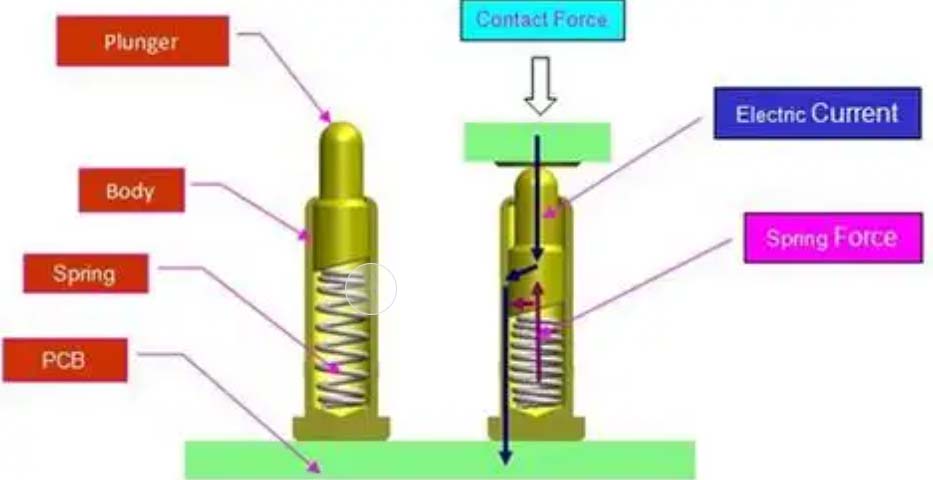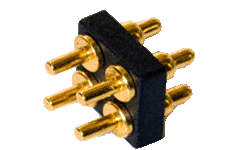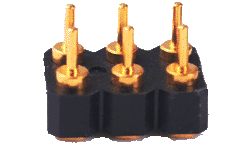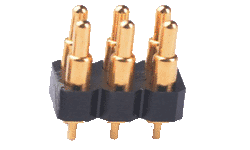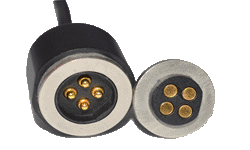2025-11-14 10:29:31
The core differences between gold-plated and nickel-plated
Pogo pins lie in conductivity, abrasion resistance, corrosion resistance, cost, and applicable scenarios. Gold plating emphasizes high performance and stability, while nickel plating focuses on basic protection and economy.
I. Pogo pin Core Performance Differences
1. Conductivity: Gold's conductivity (approximately 45.2 × 10⁶ S/m) is significantly higher than nickel's (approximately 14.3 × 10⁶ S/m). A gold plating layer reduces contact resistance, ensuring stable signal transmission, especially suitable for high-frequency, low-power scenarios.
Nickel has poor conductivity and is prone to oxidation over long-term use, forming a high-resistivity layer that affects current and signal transmission efficiency, only meeting basic conductivity requirements.
2. Abrasion Resistance and Hardness: Nickel's hardness (HV 400-500) is higher than gold's (HV 80-120). A nickel plating layer offers superior abrasion resistance, resisting frictional wear from frequent insertion and removal.
Gold is relatively soft, and pure gold plating generally has poor wear resistance. In practical applications, hard gold plating (with added cobalt, nickel, etc.) is often used to increase hardness, but it is still inferior to nickel plating.
3. Corrosion Resistance: Gold is chemically extremely stable, does not oxidize or rust, and can maintain its performance in harsh environments such as humidity, acids, and alkalis, providing significant protection.
Nickel easily forms a thin film of nickel oxide in air. While this can prevent corrosion of the internal substrate to some extent, long-term exposure to humid or corrosive environments can still lead to rust and peeling.
II. Differences in Process and Cost
1. Plating Process: Gold plating is complex, requiring a nickel base plating (to enhance gold adhesion) before gold plating. The plating thickness is typically 0.1-5μm. Hard gold plating also requires precise control of the alloy ratio and high processing accuracy.
Nickel plating is relatively simple, allowing direct electroplating onto the substrate (such as beryllium copper or phosphor bronze). The plating thickness is typically 1-10μm, with a shorter processing flow and lower operational difficulty.
2. Materials and Costs
Gold is a precious metal, and the raw material price is expensive. Combined with complex processing costs,
magnetic connector gold-plated Pogo pins are typically 2-5 times more expensive than nickel-plated products.
Nickel is inexpensive, and its processing costs are low, giving nickel-plated Pogo pins a significant price advantage, making them suitable for low-cost, high-volume applications.
III. Differences in Applicable Scenarios
1. Gold-plated Pogo pins: Suitable for high-end electronic devices such as smartphones, tablets, medical devices, and industrial control modules.
Especially suitable for applications requiring high-frequency signal transmission, low contact resistance (e.g., ≤50mΩ), long-term stable operation (insertion/removal life ≥100,000 cycles), or harsh environments (e.g., outdoor, humid environments).
2. Nickel-plated Pogo pins: Suitable for mid-to-low-end devices such as toys, ordinary remote controls, simple sensors, and disposable electronic products.
Suitable for low-frequency, high-current applications with less stringent signal transmission accuracy requirements, low insertion/removal frequency (≤10,000 cycles), and dry, clean operating environments.
IV. Differences in Additional Characteristics
Soldering Compatibility: Nickel plating has poor solderability and requires a special flux; gold plating has better solderability, but pure gold soldering is prone to "gold brittleness," requiring control of soldering temperature and time.
Adhesion: Gold plating relies on a nickel undercoat to improve adhesion; gold plating alone is prone to peeling; nickel plating can bond directly to the substrate, resulting in more stable adhesion.
Appearance: Gold plating is golden yellow, with high visual recognition; nickel plating is silver-gray, with a relatively plain appearance.
V. Selection Recommendations
For high performance, long lifespan, stable signal transmission, and sufficient budget, gold-plated (hard gold) Pogo pins are the preferred choice.
For low-cost, low-frequency devices with basic conductivity requirements, nickel-plated Pogo pins are a more cost-effective option.
For special scenarios, a composite plating layer of "nickel plating + partial gold plating" can be selected, balancing the performance of critical contacts with overall cost.
The difference between gold-plated and nickel-plated Pogo pins essentially lies in the choice between "performance priority" and "cost priority," which needs to be determined comprehensively based on equipment positioning, usage environment, transmission requirements, and budget.
